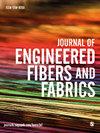基于模糊综合评价的运动服装舒适度和热湿舒适度实验研究
IF 2.2
4区 工程技术
Q1 MATERIALS SCIENCE, TEXTILES
引用次数: 0
摘要
个人的热湿舒适度受其所穿衣物的很大影响,同时也受衣物的舒适度影响。本研究旨在调查服装的舒适度对运动过程中热湿舒适度的影响。研究人员要求 17 名女性受试者穿着不同尺寸的样品服装,在气候箱中进行指定的 5 个阶段的运动。在整个运动阶段,受试者在对其舒适度进行主观评价的同时,还对衣服下微气候的温度和湿度进行了监测。为了考虑舒适度的差异,32 次实验重复根据所穿衣物的舒适度进行了分组。然后使用 FCE-CRITIC 方法确定各因素的可变权重,并将热湿状态与主观评价进行比较。结果显示,与其他阶段相比,湿度在 RS 和 RC(即跑步和运动后的恢复阶段)期间的权重更高,这意味着湿度舒适度是这两个阶段中驱动服装舒适感的主要因素。研究发现,服装的舒适度对运动时的热舒适度和湿舒适度有影响,尽管这种影响并不显著。此外,研究还确定了运动时热湿舒适度的最佳宽松度范围为 6 厘米至 10 厘米。本文章由计算机程序翻译,如有差异,请以英文原文为准。
Experimental investigation of the ease allowance of clothing and thermal-moisture comfort in exercise based on fuzzy comprehensive evaluation
The level of thermal-moisture comfort experienced by an individual is strongly influenced by the clothing they wear and also influenced by the ease allowance of that clothing. This study aimed to investigate the impact of ease allowances of clothing on thermal-moisture comfort during exercise or movement. Seventeen female subjects were asked to wear sample clothing with different sizes during a designated 5-phase exercise in a climate chamber. Throughout the exercise phases, the temperature and humidity of the microclimate under the clothing were monitored while the subjects provided subjective evaluations of their comfort levels. To account for variation in ease allowances, the 32 experimental repetitions were grouped based on the ease allowance of the clothing worn. The FCE-CRITIC method was then used to determine the variable weights of factors and to compare the thermal-moisture status to the subjective evaluation. Results revealed that humidity was more strongly weighted during RS and RC (i.e., running and recovery phase after exercise) compared to other phases, means that moisture comfort was the main factor driving the clothing comfort sensation within the two phases. The ease allowance of clothing was found to have an impact on the sensations of thermal and moisture comfort during exercise, although this effect was not significant. Furthermore, the study identified the optimum range of ease allowance for thermal-moisture comfort during exercise to be between 6 and 10 cm.
求助全文
通过发布文献求助,成功后即可免费获取论文全文。
去求助
来源期刊

Journal of Engineered Fibers and Fabrics
工程技术-材料科学:纺织
CiteScore
5.00
自引率
6.90%
发文量
41
审稿时长
4 months
期刊介绍:
Journal of Engineered Fibers and Fabrics is a peer-reviewed, open access journal which aims to facilitate the rapid and wide dissemination of research in the engineering of textiles, clothing and fiber based structures.
 求助内容:
求助内容: 应助结果提醒方式:
应助结果提醒方式:


